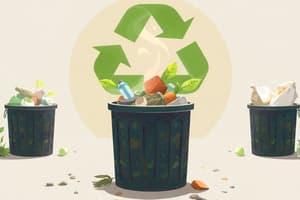Podcast
Questions and Answers
Which of the following properties of waste materials must be considered during recycling or disposal?
Which of the following properties of waste materials must be considered during recycling or disposal?
- Both A and B (correct)
- Potential hazards (corrosive, flammable, toxic)
- Volume
- State of matter
Liquids maintain a constant volume but can easily change shape.
Liquids maintain a constant volume but can easily change shape.
True (A)
What property of gases allows them to be compressed into smaller volumes?
What property of gases allows them to be compressed into smaller volumes?
The large spaces between gas particles
Materials that are ________, ________, and ________ present particular hazards and have to be handled carefully.
Materials that are ________, ________, and ________ present particular hazards and have to be handled carefully.
Match each state of matter with its ability to be compressed.
Match each state of matter with its ability to be compressed.
Which of the following statements accurately describes the volume of solids?
Which of the following statements accurately describes the volume of solids?
Solid wastes are difficult to transport in open lorries.
Solid wastes are difficult to transport in open lorries.
In what units is the volume of an object typically measured?
In what units is the volume of an object typically measured?
Liquids ________ their shape and ________, but they do not change their ________.
Liquids ________ their shape and ________, but they do not change their ________.
Match each type of waste material with its typical method of transportation, based on its properties.
Match each type of waste material with its typical method of transportation, based on its properties.
Which of the following is a property of gases?
Which of the following is a property of gases?
Factories that burn fossil fuels do not impact the environment.
Factories that burn fossil fuels do not impact the environment.
What does it mean if a substance is described as having a high density?
What does it mean if a substance is described as having a high density?
The density of gases can be changed by ________ them.
The density of gases can be changed by ________ them.
Match each substance with its corresponding state of matter.
Match each substance with its corresponding state of matter.
According to the particle theory, what are the fundamental components of all matter?
According to the particle theory, what are the fundamental components of all matter?
The forces of attraction between particles are equally strong in all states of matter.
The forces of attraction between particles are equally strong in all states of matter.
What type of movement do particles in a solid exhibit?
What type of movement do particles in a solid exhibit?
In liquids, particles have enough ________ to move around and over each other, allowing the liquid to ________.
In liquids, particles have enough ________ to move around and over each other, allowing the liquid to ________.
Match each state of matter with an attribute related to its particle arrangement and movement.
Match each state of matter with an attribute related to its particle arrangement and movement.
Which of the following best describes the arrangement of particles in a gas?
Which of the following best describes the arrangement of particles in a gas?
The volume of a gas decreases when its density decreases.
The volume of a gas decreases when its density decreases.
The process by which particles of one substance spread through another is called what?
The process by which particles of one substance spread through another is called what?
When soluble solids ________ in liquids, the solid particles are separated and spread through the liquid.
When soluble solids ________ in liquids, the solid particles are separated and spread through the liquid.
Match each state of matter with its ability to fill available space.
Match each state of matter with its ability to fill available space.
What is the name given to the random movement of microscopic particles suspended in a fluid, caused by collisions with surrounding molecules?
What is the name given to the random movement of microscopic particles suspended in a fluid, caused by collisions with surrounding molecules?
Brownian motion can only be observed in liquids.
Brownian motion can only be observed in liquids.
Who was the scientist who first observed the random motion of pollen grains in water under a microscope?
Who was the scientist who first observed the random motion of pollen grains in water under a microscope?
According to the particle model, air consists of tiny ________ moving about in all directions.
According to the particle model, air consists of tiny ________ moving about in all directions.
Match each observation with its explanation based on the particle theory and Brownian motion.
Match each observation with its explanation based on the particle theory and Brownian motion.
What is the term for the measure of one billionth of a meter?
What is the term for the measure of one billionth of a meter?
Diffusion occurs more slowly in liquids than in gases due to the particles being closer together.
Diffusion occurs more slowly in liquids than in gases due to the particles being closer together.
Define diffusion and explain why smells can spread through a room.
Define diffusion and explain why smells can spread through a room.
Diffusion is an important process in living things because it facilitates the movement of substances ________ and ________ of cells.
Diffusion is an important process in living things because it facilitates the movement of substances ________ and ________ of cells.
Match the state of matter to whether gas pressure is applicable.
Match the state of matter to whether gas pressure is applicable.
Flashcards
Corrosive Materials
Corrosive Materials
Materials that can cause harm due to their chemical properties.
Flammable Materials
Flammable Materials
Materials that ignite easily and burn rapidly.
Toxic Materials
Toxic Materials
Materials that are poisonous or harmful if ingested or inhaled.
States of Matter
States of Matter
Signup and view all the flashcards
Properties of Solids
Properties of Solids
Signup and view all the flashcards
Volume
Volume
Signup and view all the flashcards
Compressibility of Solids
Compressibility of Solids
Signup and view all the flashcards
Properties of Liquids
Properties of Liquids
Signup and view all the flashcards
Liquid flow
Liquid flow
Signup and view all the flashcards
Properties of Gases
Properties of Gases
Signup and view all the flashcards
Density
Density
Signup and view all the flashcards
Particle Theory of Matter
Particle Theory of Matter
Signup and view all the flashcards
Particle arrangement in Solids
Particle arrangement in Solids
Signup and view all the flashcards
Particle Arrangement in Liquids
Particle Arrangement in Liquids
Signup and view all the flashcards
Particle Arrangement in Gases
Particle Arrangement in Gases
Signup and view all the flashcards
Brownian Motion
Brownian Motion
Signup and view all the flashcards
Diffusion
Diffusion
Signup and view all the flashcards
Diffusion States
Diffusion States
Signup and view all the flashcards
Concentration Gradient in Diffusion
Concentration Gradient in Diffusion
Signup and view all the flashcards
Air Pressure
Air Pressure
Signup and view all the flashcards
Gas Pressure
Gas Pressure
Signup and view all the flashcards
Temperature and Pressure
Temperature and Pressure
Signup and view all the flashcards
Volume and Pressure
Volume and Pressure
Signup and view all the flashcards
Incineration
Incineration
Signup and view all the flashcards
A good theory
A good theory
Signup and view all the flashcards
Study Notes
- Waste materials have different properties which must be considered when recycling or disposing of them.
- Corrosive, flammable, and toxic materials pose hazards and require careful handling.
- Waste exists in three states of matter: solid, liquid, and gas, handled differently during recycling and disposal.
Solids
- Generally, solids don't flow or change shape; they stay in place unless moved.
- Volume is measured in cubic centimetres (cm³).
- Solids are hard to compress.
- Solid waste like metals, paper, and plastic is easily transported in open lorries to landfill sites.
Liquids
- Liquids take the shape of their container and can flow.
- It would be difficult to transport them in an open truck because they slosh and spill
- Liquids don't change volume and are hard to compress.
- Liquid wastes can be pumped along pipelines due to flow.
Gases
- Gases change their shape and volume, spreading in all directions and easily compressing.
- Gas cylinders store gases under pressure.
- Flammable gases in cylinders pose explosion or fire risks in recycling plants.
- The release of many waste gases into the atmosphere can harm the environment
- Power stations burn fossil fuels and produce acidic gases.
Density
- Density helps identify a substance
- Mass of a certain volume of material, is measured in kilograms per cubic metre (kg/m³) or grams per cubic centimetre (g/cm³).
- Iron has a density of 7.9 g/cm³, meaning 1 cm³ has a mass of 7.9 g.
- Iron is denser than water (1 g/cm³), so 1 cm³ of iron weighs more than 1 cm³ of water.
- Generally, solids are denser than liquids, and liquids are denser than gases.
- The density of gases can be changed by squashing them.
Solids-Particles
- Particles in solids are tightly packed, cannot be compressed and arranged in a regular way.
- Attraction forces between particles hold them in place.
- Solids expand when heated.
- Particles vibrate in a fixed position, giving solids fixed shape and meaning they cannot flow.
Liquids- Particles
- Particles are arranged randomly but close, touching neighbours.
- Liquids cannot be compressed.
- Particles have enough energy to overcome some attraction forces, allowing movement and pouring.
Gases- Particles
- Particles are widely spaced and randomly arranged so the gases can be easily compressed or squashed.
- Particles have enough energy to overcome attraction, moving freely in straight lines and colliding with container walls
Particle Theory
- All matter consists of tiny particles in constant motion, held together by varying forces of attraction.
- In solids, particles are closely held by strong forces, vibrating but not moving past each other.
- In liquids, particles are close with moderate forces, allowing them to move past each other, like marbles in a bucket.
- In gases, particles are far apart with weak forces, allowing quick, random movement to fill the container.
Diffusion
- Brownian motion was first observed in 1827 by Robert Brown, studying pollen grains in water and discovering they moved randomly.
- Air consists of moving particles that collide with smoke specks, pushing them in different directions to demonstrate diffusion
- Diffusion is the process where particles spread from high to low concentration areas
- It occurs in liquids and gases due to random particle collisions like smelly substances spreading through the air
Nanoscale
- Though pollen grains and smoke specks are only visible using a microscope, they are more than 100,000 times larger than molecules in water or air.
- Nanometres (nm) are used to measure such small particles; 1 nm equals 0.000000001 meters.
- Brownian motion is important to scientists, including those studying paints, air pollution, and electronics.
Gas pressure
- Gas pressure is the result of gas particles constantly colliding with surfaces.
- More collisions equate to more pressure.
- Gas pressure is increased when the temperature increases or volume decreases
- Decreasing the volume of a sealed container containing a gas, results in more frequent collisions with the walls, which results in increasing the pressure.
Scientific Method
- Scientific Method begins with observation, forming a hypothesis, and making a prediction
- Experimentation then tests the hypothesis, and results are compared to the prediction
- A hypothesis supported by many experiments becomes a theory.
- Salty water takes longer to boil, boiling point of water depends on amount of salt added, predictions should be "if" "then" statements
Studying That Suits You
Use AI to generate personalized quizzes and flashcards to suit your learning preferences.




